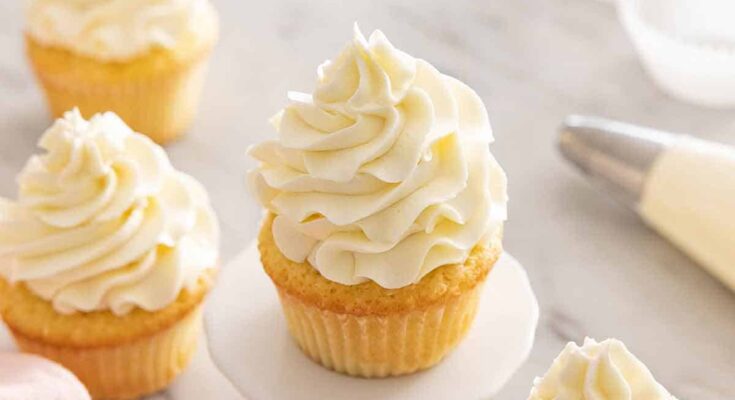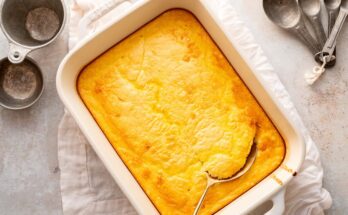Buttercream Swiss Meringue Recipe: Swiss Meringue Buttercream, often called SMBC, is one of the most elegant and versatile frostings you can make at home. Unlike traditional buttercream, which can sometimes feel overly sweet and grainy, Swiss Meringue Buttercream has a silky-smooth texture and a light, airy taste that melts in your mouth. If you’ve ever wondered how professional bakers get that perfect glossy finish on cakes, the answer often lies in this magical frosting.
So, what makes it special? The magic begins with egg whites and sugar, which are gently heated over a double boiler to create a glossy meringue. This base is then whipped with butter to transform into a creamy, fluffy buttercream that’s easy to spread and pipe. Not only does it taste heavenly, but it’s also stable enough to decorate elaborate cakes and cupcakes.
Why should you choose Swiss Meringue Buttercream over other frostings? The simple answer is its balance. Unlike American buttercream, which can be overly sugary, SMBC has a subtle sweetness and velvety texture. It pairs perfectly with both light sponge cakes and rich chocolate desserts, making it a versatile option for all kinds of baked goods.
Another highlight is its adaptability. Once you master the basic recipe, you can infuse it with endless flavors—vanilla, chocolate, coffee, fruit purees, or even caramel. Whether you want a classic vanilla frosting for a birthday cake or a sophisticated espresso buttercream for a wedding dessert, this recipe can do it all.
In this step-by-step guide, we’ll walk through everything you need—from ingredients and tools to foolproof tips—so you can confidently whip up your own batch of Swiss Meringue Buttercream at home. Ready to dive in? Let’s get started with the essentials.
Ingredients You’ll Need
Before you start, it’s important to gather everything you’ll need. Baking is like science—it requires precision. Having the right ingredients and tools on hand makes the process smooth and stress-free.
Basic Ingredients for Swiss Meringue Buttercream
Here’s the classic ingredient list you’ll need for about 6 cups of buttercream, enough to frost a two-layer cake or around 24 cupcakes:
- 5 large egg whites (room temperature works best)
- 1 ½ cups (300 g) granulated sugar
- 2 cups (450 g) unsalted butter, softened but cool
- 1 teaspoon pure vanilla extract
- A pinch of salt
That’s it—just a few simple ingredients transform into something extraordinary.
Optional Flavor Variations
This buttercream is like a blank canvas, ready to be flavored and customized. Here are some add-ons you can try:
- Chocolate: Add 4–6 ounces of melted and cooled semi-sweet chocolate.
- Fruit: Stir in ½ cup of fruit puree (raspberry, strawberry, or mango).
- Coffee: Dissolve 1 tablespoon of instant espresso powder in 1 tablespoon of hot water, then mix it in.
- Caramel: Swirl in ½ cup of salted caramel sauce for a decadent twist.
Tools and Equipment Required
Having the right tools ensures your buttercream turns out perfectly every time. Here’s what you’ll need:
- Stand mixer with whisk and paddle attachments (a hand mixer works, but it’ll take longer)
- Heatproof mixing bowl
- Saucepan for the double boiler method
- Rubber spatula
- Kitchen thermometer (optional but helpful to check sugar temperature)
With your ingredients prepped and tools ready, you’re halfway there. The next step is to bring everything together with a precise but simple method.
Step-by-Step Guide to Making Swiss Meringue Buttercream
Now comes the fun part—actually making the buttercream. Don’t be intimidated by the word “meringue.” Once you understand the process, it’s straightforward. Just follow these steps carefully.
Step 1 – Preparing the Ingredients
Preparation is key. Start by separating your egg whites from the yolks. Make sure not a single drop of yolk slips in—any fat can prevent the whites from whipping properly. Place the egg whites in a clean, grease-free bowl.
Measure out your sugar and butter. The butter should be softened but still cool to the touch. If it’s too warm, your buttercream may turn soupy. A good trick is to cut your butter into small cubes and let them sit at room temperature for about 20 minutes.
Step 2 – Whisking Egg Whites and Sugar
Place your egg whites and sugar in a heatproof bowl. Set this bowl over a pot of simmering water (don’t let the bottom of the bowl touch the water). Whisk constantly until the sugar dissolves completely. You’ll know it’s ready when the mixture feels warm to the touch and you can’t feel any sugar granules between your fingers.
If you’re using a thermometer, aim for about 160°F (70°C)—this ensures the eggs are safe to eat. This step is crucial for creating a stable meringue.
Step 3 – Beating Until Stiff Peaks Form
Once the sugar is dissolved, transfer the bowl to your stand mixer fitted with a whisk attachment. Beat the mixture on high speed until it becomes glossy and forms stiff peaks. This can take 8–10 minutes.
At this stage, your bowl should feel cool to the touch. If it’s still warm, keep beating until it cools down. This step is critical because adding butter to warm meringue can cause it to melt and ruin the texture.
Step 4 – Adding Butter Gradually
Now switch to the paddle attachment. With the mixer running on medium speed, add the butter one cube at a time. At first, the mixture might look soupy or curdled—don’t panic! Keep beating, and it will come together beautifully.
Once all the butter is incorporated, add your vanilla extract and a pinch of salt. Mix until smooth and creamy.
Step 5 – Achieving the Perfect Smooth Buttercream
Your Swiss Meringue Buttercream should now be silky, fluffy, and spreadable. If it looks too soft, refrigerate it for about 10 minutes, then whip again. If it’s too stiff, let it sit at room temperature for a few minutes before using.
At this point, you can use it immediately to frost cakes and cupcakes or store it for later.
Tips for Success
Even though this recipe is reliable, a few small mistakes can cause issues. But don’t worry—we’ve got troubleshooting tips to keep you on track.
Common Mistakes and How to Fix Them
- Buttercream looks soupy → Keep whipping; it usually comes together. If not, chill the bowl for 10 minutes, then whip again.
- Buttercream looks curdled → Keep beating—it will smooth out.
- Too soft to pipe → Refrigerate briefly to firm it up.
- Too stiff → Warm the bowl slightly and re-whip.
How to Save a “Broken” Buttercream
Sometimes, the mixture separates or refuses to smooth out. The trick is to adjust the temperature. If it’s too cold, warm the bowl slightly with a warm towel wrapped around it. If it’s too warm, chill it for a few minutes.
Storage and Make-Ahead Tips
Swiss Meringue Buttercream can be made ahead of time and stored:
- At room temperature: Up to 2 days in a cool environment.
- In the refrigerator: Up to 1 week.
- In the freezer: Up to 2 months.
Before using, let it come to room temperature and re-whip for the perfect consistency.
Flavoring and Variations
Swiss Meringue Buttercream is like a blank canvas—beautifully smooth, creamy, and ready to be transformed into almost any flavor you can imagine. Once you’ve mastered the basic recipe, you’ll find it’s incredibly versatile. Let’s dive into some of the most popular variations and how you can use them to elevate your desserts.
Adding Vanilla, Chocolate, or Fruit Flavors
The simplest and most common way to flavor your buttercream is with vanilla extract. A teaspoon or two of pure vanilla gives a delicate sweetness that pairs with nearly any cake. But why stop there?
- Chocolate Buttercream: Melt 4–6 ounces of semi-sweet or dark chocolate, let it cool slightly, and whip it into your finished buttercream. This creates a rich, luxurious chocolate frosting.
- Fruit Buttercream: Puree fresh fruits like strawberries, raspberries, or mangoes, then strain them to remove seeds and excess water. Stir ½ cup of this thick puree into your buttercream for a naturally fruity twist.
- Citrus Zest: Grated lemon, orange, or lime zest adds brightness without overpowering sweetness.
Each flavor addition not only changes the taste but also adds color, making your frosting visually stunning.
Creative Flavors for Special Occasions
If you want to get more adventurous, consider these fun variations:
- Espresso or Coffee: Dissolve instant espresso powder in hot water and whip it in for a grown-up, café-style buttercream.
- Caramel Swirl: Fold in salted caramel sauce for a decadent, toffee-like flavor.
- Nut Butters: Add a few spoonfuls of peanut butter, almond butter, or hazelnut spread for a nutty depth.
- Holiday Flavors: Peppermint extract for Christmas, pumpkin spice for autumn, or lavender for spring celebrations.
These unique twists are perfect for tailoring desserts to special events and seasons.
Using Swiss Meringue Buttercream for Decorating Cakes and Cupcakes
Beyond taste, Swiss Meringue Buttercream is a baker’s dream when it comes to decorating. Its silky texture makes it ideal for:
- Smooth Cake Finishes: It spreads like velvet, giving cakes a professional, flawless look.
- Piping: With the right tips, you can pipe roses, swirls, or intricate borders that hold their shape beautifully.
- Layering: Because it’s not overly sweet, you can use generous amounts between cake layers without overwhelming the dessert.
Whether you’re making a rustic naked cake or an elaborate wedding creation, this buttercream adapts to your vision.
Nutritional Information
Now, let’s talk about what’s inside a serving of this dreamy frosting. While Swiss Meringue Buttercream isn’t exactly diet food, it is lighter in sugar compared to American buttercream. That means you get all the flavor and creaminess without it being cloyingly sweet.
Calories and Serving Size
On average, a 2-tablespoon serving contains:
- Calories: 120–140
- Fat: 10–12 g (mostly from butter)
- Carbohydrates: 10–12 g (mainly from sugar)
- Protein: 1–2 g (from egg whites)
Of course, actual nutrition depends on the exact recipe and added flavors.
Healthier Alternatives
If you’re looking to lighten things up:
- Use less sugar: Swiss Meringue is naturally less sweet, but you can reduce the sugar slightly.
- Try butter substitutes: Half butter and half unsalted margarine can cut down on saturated fat.
- Add fruit: Mixing in fruit purees reduces fat per serving while boosting flavor and color naturally.
Though it’s still a treat, these small adjustments can make it a bit friendlier for those watching their sugar or fat intake.
FAQs about Buttercream Swiss Meringue Recipe
1. Can I freeze Swiss Meringue Buttercream?
Yes! Store it in an airtight container for up to 2 months. Thaw at room temperature, then re-whip to restore its silky texture.
2. How long can Swiss Meringue Buttercream sit out?
It’s safe at room temperature for about 2 days, provided your kitchen isn’t too warm. After that, refrigerate or freeze it.
3. Why is my buttercream too runny?
This usually happens if the meringue was too warm when adding butter. Chill it for 10–15 minutes, then whip again.
4. Can I use salted butter instead of unsalted?
You can, but it’s not recommended. Salted butter alters the taste and can make the frosting too salty. Stick with unsalted for best results.
5. Is Swiss Meringue Buttercream good for hot weather?
It holds up better than whipped cream but can soften in extreme heat. Keep cakes refrigerated until serving if your environment is warm.
Conclusion
What makes it truly special is its balance: sweet but not overwhelming, creamy yet light, and endlessly versatile. Whether you stick to the classic vanilla version or explore exciting flavors like chocolate, espresso, or fruity variations, this buttercream will become your go-to recipe for every occasion.
It might feel intimidating at first, especially with the heating and whipping steps, but once you get the hang of it, you’ll see just how easy it is to whip up bakery-quality frosting at home. The key is patience, precision, and a little bit of practice.
So next time you’re baking a cake or cupcakes, skip the store-bought frosting and try making this elegant, professional-quality Swiss Meringue Buttercream. Your desserts—and your taste buds—will thank you.



